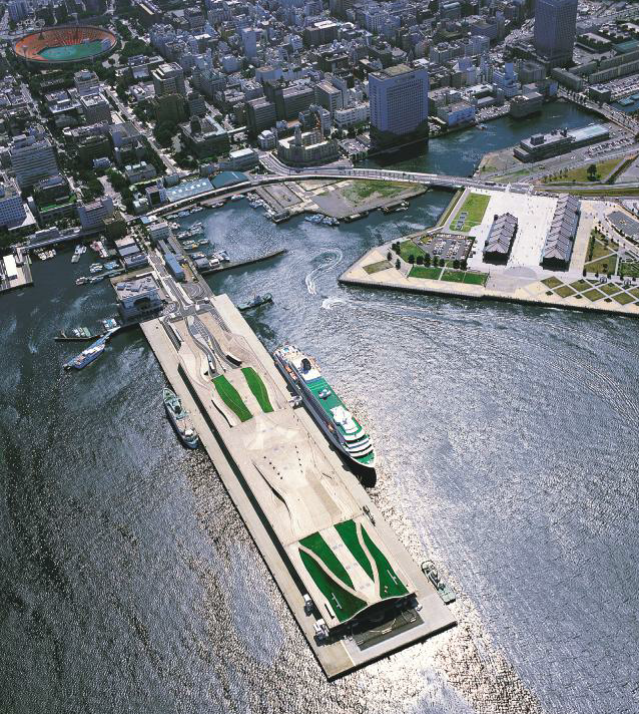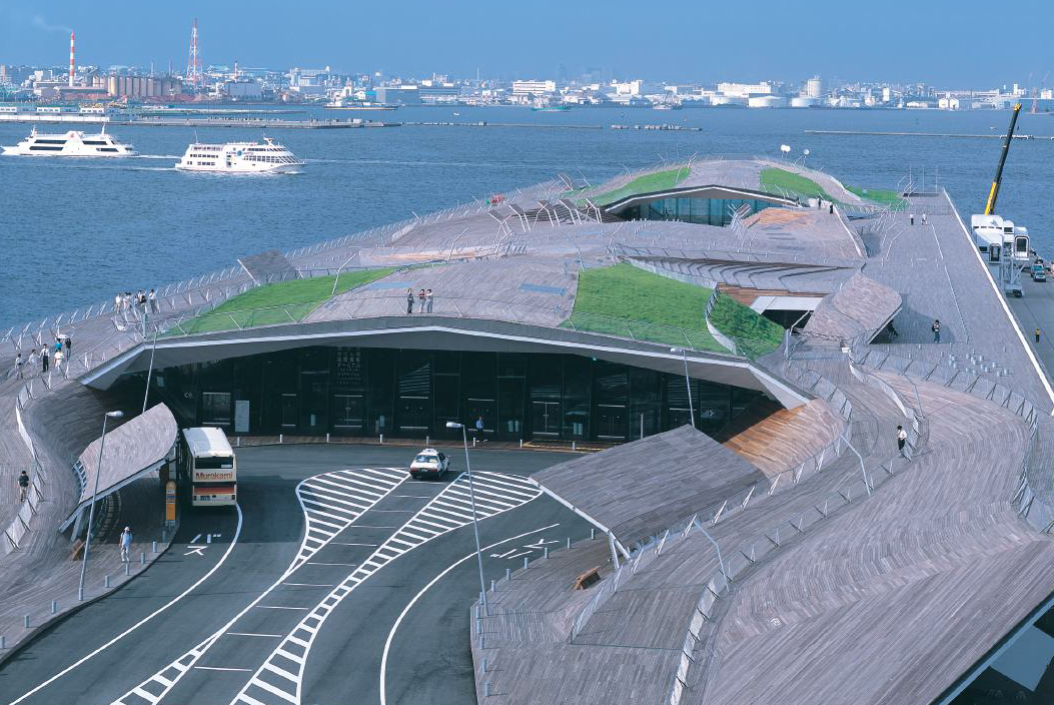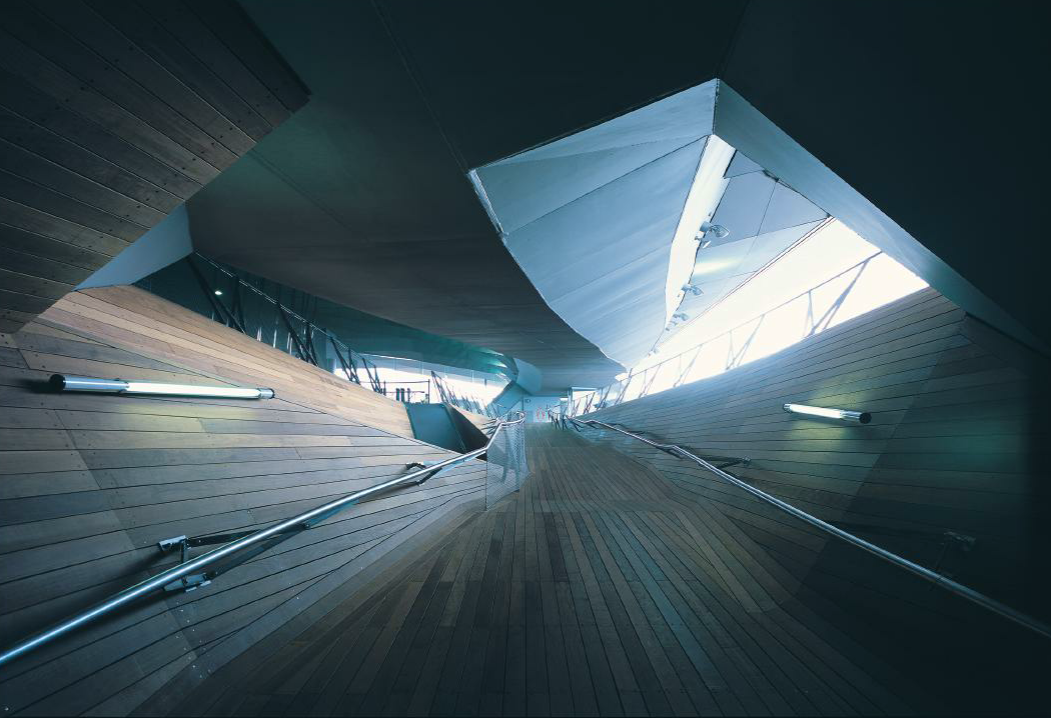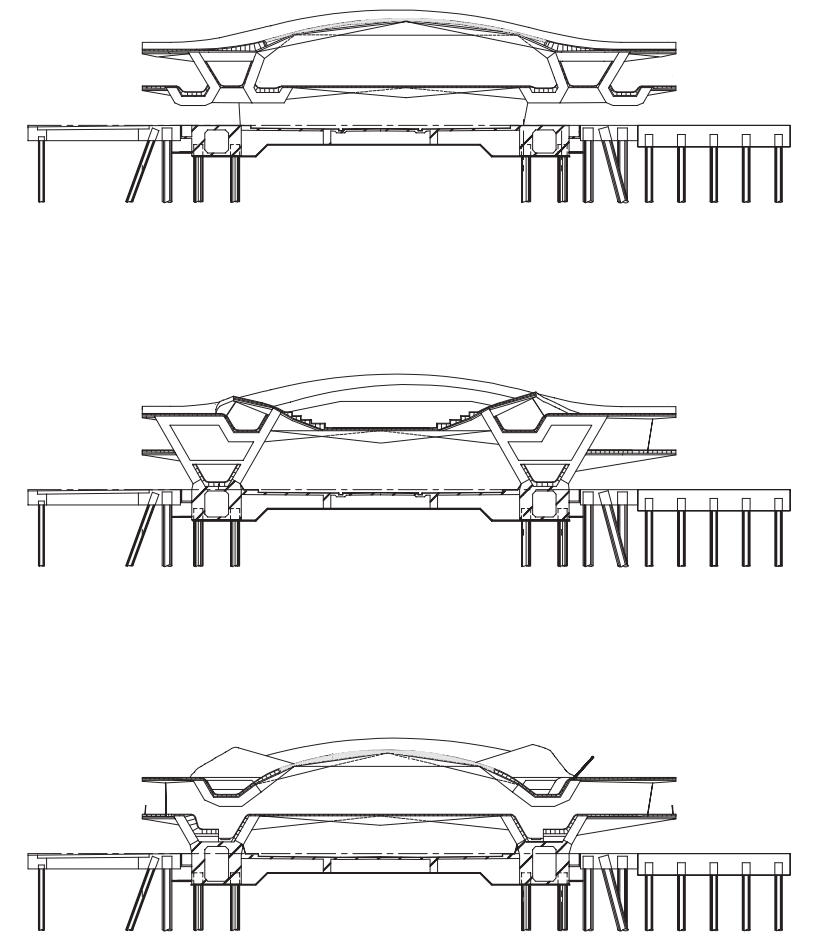Yokohama International Port Terminal. Yokohama, Japan, 1995 to 2002
The Yokohama International Port Terminal by Foreign Office Architects (FOA) strikes with surprise, as it is on the one hand thoroughly modernist in character while on the other hand it just as thoroughly transcends its modernist characteristics. The project clearly features Le Corbusier's five points of architecture, namely pilotis, free fagade, free plan, ribbon windows and roof garden, and his notion of the architectural promenade as perhaps most clearly embodied in his seminal Villa Savoye (1929-1931).
Yet, one needs to imagine Villa Savoy, stretched to 400 metres in length and 70 metres in width, with one short end compressed into a single layer from which all levels of the building bifurcate and the organization of which evolves from a looped circulation pattern.
FOA won the international design competition for the new terminal in 1995.

Aerial view of the Yokohama International Port Terminal showing the terminal as an extension of the city infrastructure and green spaces, as well as a distinctly landscaped surface. From this viewpoint the presence of the building as a separate entity diminishes and what comes to the fore is a non-discrete architecture at the city scale. Copyright: Foreign Office Architects. Photography: Satoru Mishima

View of the entrance to the terminal and the landscape roof. Here all surfaces of the building meet in a circulation plaza. Copyright: Foreign Office Architects. Photography: Satoru Mishima

View of the ramped spaces that constitute extended thresholds between the parking level, terminal hall and the landscape roof. The appearance is partly one of burrowed spaces within a thick ground and partly suggests the continuation of the timber decking of the landscaped roof level. Copyright: Foreign Office Architects. Photography: Satoru Mishima
Based on the starting concept 'ni-wa-minato' proposed by the client, which addresses a mediation between harbour and garden, as well as the local citizens and the world, the scheme integrates public spaces and the controlled spaces of the terminal. In so doing the scheme constitutes a 'hybridisation between a shed like canopy - a non-discrete container - and a ground' (Moussavi and Zaera Polo 1995: 14).
FOA took explicit interest in how circulation could shape space with circulation organized as loops and choices between multiple paths through the building. This was articulated and intensified by the articulation of the building surface which coordinates and correlates circulation, activities and events.
The scheme was developed through a sectional approach that deployed serial sections and that treated the entire built volume as a thick ground. Inspired by the principles of origami, the traditional Japanese art of paper folding, the folding of the surfaces of the project produces creases along the length of the building volume that provide both paths as well as structural capacity.
In deploying this approach across scales, the initial scheme featured an interesting approach towards articulating the surfaces that the architects termed 'mille-feuille' and that make up the building as a series of self-similar folded steel sheets in various sizes nested within one another. In articulating the scheme in this way the project transcends the traditional modernist paradigm of separating building elements in functional terms.
The final scheme adapts the structure to the continual changing in its cross-sectional requirements. Each section is particularized to create varying spatial conditions and provisions ranging from circulation paths to large halls to inclined areas that integrate stairs with seating for spectators, semi-sheltered conditions and so on.
This new ground defined by the scheme employs two primary and two secondary surface materials that define and provide for the use of these surfaces. These include the painted steel plate structure that defines the underside of the new ground condition and which also becomes the ceiling surface of the interior spaces and the timber surface which defines the walkable areas and that becomes the roof landscape and the floor of the programmed interior spaces. Both of these surface materials have a grain and directionality to them.

These four cross-sections show the sectional variation that runs through the scheme, as well as the spatial transition from interior, to semi-interior exterior, to full exterior and back again. Copyright: Foreign Office Architects
The folded steel plate’s directionality and grain are linked with the structural demands of span and to the cross-sectional spatial requirements that it needs to achieve. Where it defines the ceiling plane of the interior it acts additionally as a lighting reflector to illuminate the deep spaces, and some areas of the surface are perforated to accommodate air-conditioning systems located between that surface and the timber surface of the roof. The timber surface has a grain operating within a more intimate human scale of tactility. This is the surface with which visitors come more readily into contact.
This surface has a directionality that is oriented opposite to the direction of the steel surfaces. Running along the length of the building this surface grain leads visitors into and on to it, and provides for transitional spaces such as ramps and steps, as well as informal areas for seating and events. The timber used for this project is a Brazilian hardwood called Ipe that is commonly used in the construction of piers, which is resistant to weathering and acquires a grey coloration. In so doing this subtle change begins to define the transition between interior and exterior based on the tonal shift of the same material: as one walks across the roof landscape one notices the gradient shifts in tones from a lighter grey to a darker richer coloration.
The secondary materials are the grass patches on the roof surfaces and the vertical surfaces of glazing that complete the climatic enclosure of the scheme. The former is used on the exterior roof landscape; it provides areas for informal use and implies the extension of the surrounding public gardens. In so doing the combination of timber decking and grass surfaces articulates the concept of ‘ni-wa-minato’, the mediation between harbour and garden, on a material scale. The broad range of public activities that take place on the roof landscape confirms the validity of FOA’s intentions and approach to the design of a public landscape. Given the programmatic needs of the passenger terminal and its location on a pier, the perimeter of the scheme needed to be clearly demarcated and, when seen from a distance at pedestrian level, the object remains necessarily accentuated.
Yet, when approaching the project and entering it, the object no longer takes primacy and recedes, giving way to the perception of various ways of inhabiting ground. In a series of unbuilt projects with different, more gradual perimeter conditions FOA experimented with a similar design approach, thus blending the respective schemes in such ways that give no primacy to the architectural object, while at the same time maintaining distinct architectural traits. In this respect it is of interest to compare the Yokohama scheme with their later project for the Meydan Retail Complex & Multiplex in Istanbul, Turkey (see p. 111).
Date added: 2025-08-01; views: 272;
